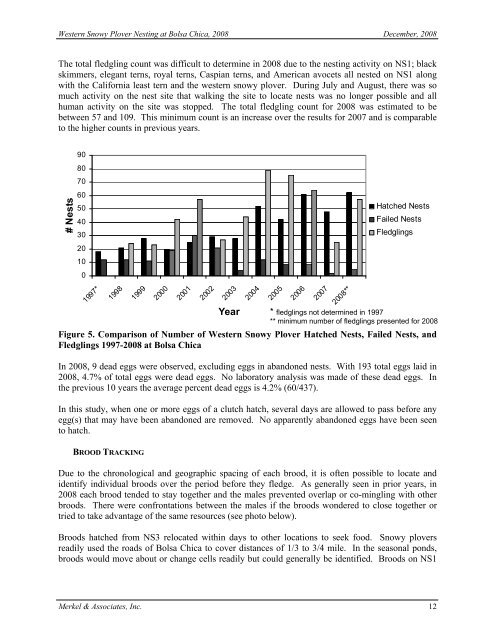2008 Annual Monitoring Report (pdf 10.9MB) - Bolsa Chica ...
2008 Annual Monitoring Report (pdf 10.9MB) - Bolsa Chica ...
2008 Annual Monitoring Report (pdf 10.9MB) - Bolsa Chica ...
Create successful ePaper yourself
Turn your PDF publications into a flip-book with our unique Google optimized e-Paper software.
Western Snowy Plover Nesting at <strong>Bolsa</strong> <strong>Chica</strong>, <strong>2008</strong> December, <strong>2008</strong><br />
The total fledgling count was difficult to determine in <strong>2008</strong> due to the nesting activity on NS1; black<br />
skimmers, elegant terns, royal terns, Caspian terns, and American avocets all nested on NS1 along<br />
with the California least tern and the western snowy plover. During July and August, there was so<br />
much activity on the nest site that walking the site to locate nests was no longer possible and all<br />
human activity on the site was stopped. The total fledgling count for <strong>2008</strong> was estimated to be<br />
between 57 and 109. This minimum count is an increase over the results for 2007 and is comparable<br />
to the higher counts in previous years.<br />
# Nests<br />
90<br />
80<br />
70<br />
60<br />
50<br />
40<br />
30<br />
20<br />
10<br />
0<br />
Hatched Nests<br />
Failed Nests<br />
Fledglings<br />
1997*<br />
1998<br />
1999<br />
2000<br />
2001<br />
2002<br />
2003<br />
Year<br />
Figure 5. Comparison of Number of Western Snowy Plover Hatched Nests, Failed Nests, and<br />
Fledglings 1997-<strong>2008</strong> at <strong>Bolsa</strong> <strong>Chica</strong><br />
In <strong>2008</strong>, 9 dead eggs were observed, excluding eggs in abandoned nests. With 193 total eggs laid in<br />
<strong>2008</strong>, 4.7% of total eggs were dead eggs. No laboratory analysis was made of these dead eggs. In<br />
the previous 10 years the average percent dead eggs is 4.2% (60/437).<br />
In this study, when one or more eggs of a clutch hatch, several days are allowed to pass before any<br />
egg(s) that may have been abandoned are removed. No apparently abandoned eggs have been seen<br />
to hatch.<br />
2004<br />
2005<br />
2006<br />
2007<br />
<strong>2008</strong>**<br />
* fledglings not determined in 1997<br />
** minimum number of fledglings presented for <strong>2008</strong><br />
BROOD TRACKING<br />
Due to the chronological and geographic spacing of each brood, it is often possible to locate and<br />
identify individual broods over the period before they fledge. As generally seen in prior years, in<br />
<strong>2008</strong> each brood tended to stay together and the males prevented overlap or co-mingling with other<br />
broods. There were confrontations between the males if the broods wondered to close together or<br />
tried to take advantage of the same resources (see photo below).<br />
Broods hatched from NS3 relocated within days to other locations to seek food. Snowy plovers<br />
readily used the roads of <strong>Bolsa</strong> <strong>Chica</strong> to cover distances of 1/3 to 3/4 mile. In the seasonal ponds,<br />
broods would move about or change cells readily but could generally be identified. Broods on NS1<br />
Merkel & Associates, Inc. 12






